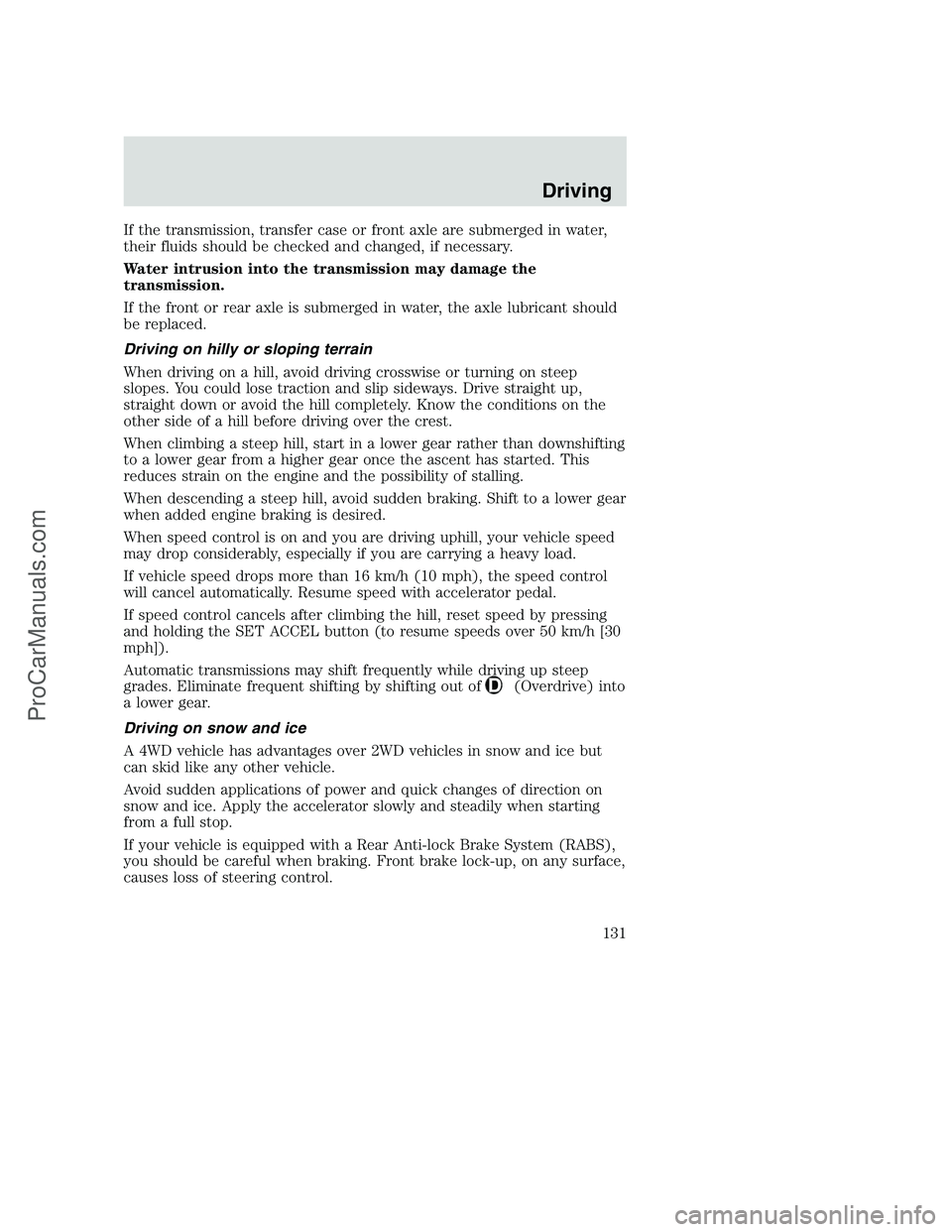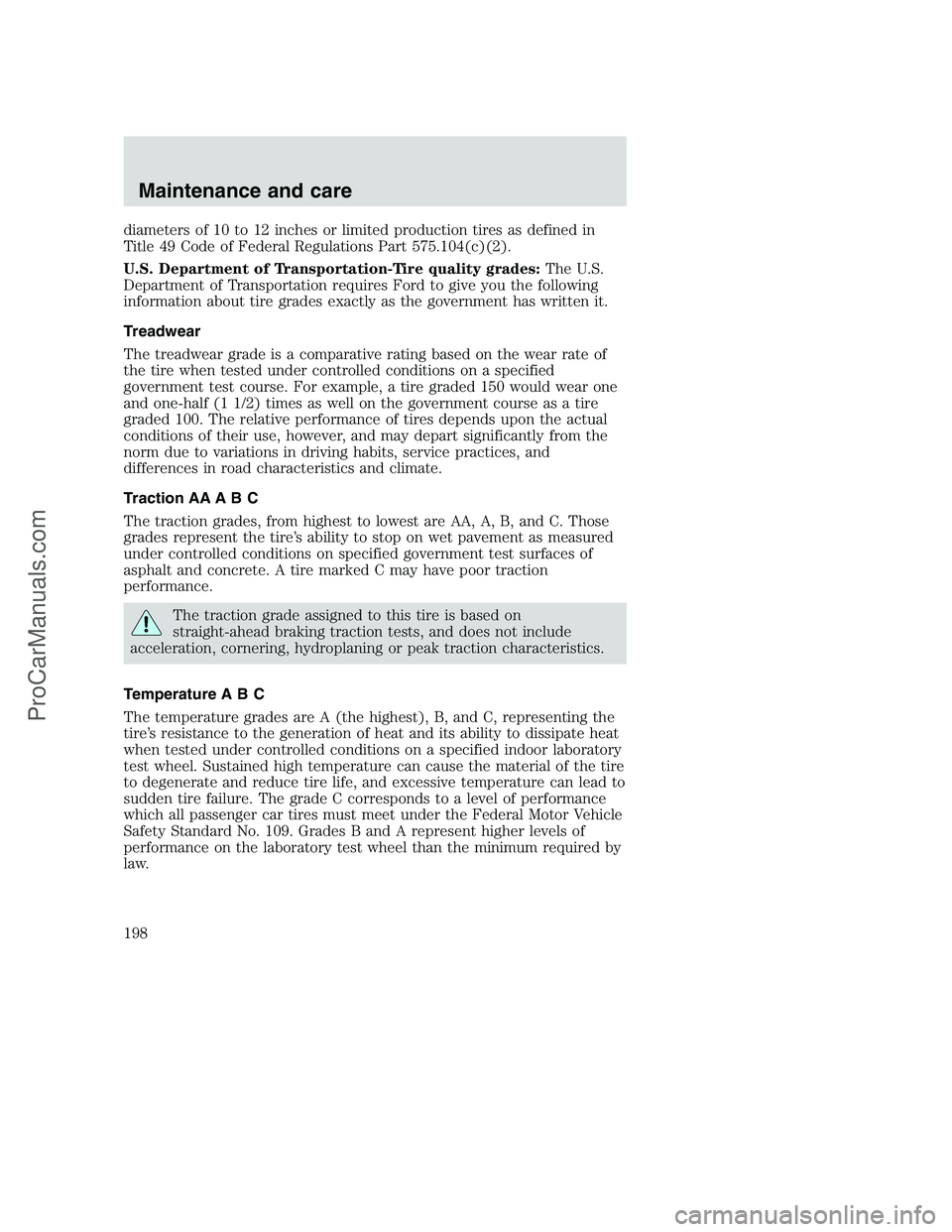2000 FORD F350 traction control
[x] Cancel search: traction controlPage 6 of 256

These are some of the symbols you may see on your vehicle.
Vehicle Symbol Glossary
Safety Alert
See Owner’s Guide
Fasten Safety BeltAir Bag-Front
Air Bag-SideChild Seat
Child Seat Installation
WarningChild Seat Tether
Anchorage
Brake SystemAnti-Lock Brake System
Brake Fluid -
Non-Petroleum BasedTraction Control
Master Lighting SwitchHazard Warning Flasher
Fog Lamps-FrontFuse Compartment
Fuel Pump ResetWindshield Wash/Wipe
Windshield
Defrost/DemistRear Window
Defrost/Demist
Power Windows
Front/RearPower Window Lockout
Introduction
6
ProCarManuals.com
Page 131 of 256

If the transmission, transfer case or front axle are submerged in water,
their fluids should be checked and changed, if necessary.
Water intrusion into the transmission may damage the
transmission.
If the front or rear axle is submerged in water, the axle lubricant should
be replaced.
Driving on hilly or sloping terrain
When driving on a hill, avoid driving crosswise or turning on steep
slopes. You could lose traction and slip sideways. Drive straight up,
straight down or avoid the hill completely. Know the conditions on the
other side of a hill before driving over the crest.
When climbing a steep hill, start in a lower gear rather than downshifting
to a lower gear from a higher gear once the ascent has started. This
reduces strain on the engine and the possibility of stalling.
When descending a steep hill, avoid sudden braking. Shift to a lower gear
when added engine braking is desired.
When speed control is on and you are driving uphill, your vehicle speed
may drop considerably, especially if you are carrying a heavy load.
If vehicle speed drops more than 16 km/h (10 mph), the speed control
will cancel automatically. Resume speed with accelerator pedal.
If speed control cancels after climbing the hill, reset speed by pressing
and holding the SET ACCEL button (to resume speeds over 50 km/h [30
mph]).
Automatic transmissions may shift frequently while driving up steep
grades. Eliminate frequent shifting by shifting out of
(Overdrive) into
a lower gear.
Driving on snow and ice
A 4WD vehicle has advantages over 2WD vehicles in snow and ice but
can skid like any other vehicle.
Avoid sudden applications of power and quick changes of direction on
snow and ice. Apply the accelerator slowly and steadily when starting
from a full stop.
If your vehicle is equipped with a Rear Anti-lock Brake System (RABS),
you should be careful when braking. Front brake lock-up, on any surface,
causes loss of steering control.
Driving
131
ProCarManuals.com
Page 198 of 256

diameters of 10 to 12 inches or limited production tires as defined in
Title 49 Code of Federal Regulations Part 575.104(c)(2).
U.S. Department of Transportation-Tire quality grades:The U.S.
Department of Transportation requires Ford to give you the following
information about tire grades exactly as the government has written it.
Treadwear
The treadwear grade is a comparative rating based on the wear rate of
the tire when tested under controlled conditions on a specified
government test course. For example, a tire graded 150 would wear one
and one-half (1 1/2) times as well on the government course as a tire
graded 100. The relative performance of tires depends upon the actual
conditions of their use, however, and may depart significantly from the
norm due to variations in driving habits, service practices, and
differences in road characteristics and climate.
Traction AA A B C
The traction grades, from highest to lowest are AA, A, B, and C. Those
grades represent the tire’s ability to stop on wet pavement as measured
under controlled conditions on specified government test surfaces of
asphalt and concrete. A tire marked C may have poor traction
performance.
The traction grade assigned to this tire is based on
straight-ahead braking traction tests, and does not include
acceleration, cornering, hydroplaning or peak traction characteristics.
Temperature A B C
The temperature grades are A (the highest), B, and C, representing the
tire’s resistance to the generation of heat and its ability to dissipate heat
when tested under controlled conditions on a specified indoor laboratory
test wheel. Sustained high temperature can cause the material of the tire
to degenerate and reduce tire life, and excessive temperature can lead to
sudden tire failure. The grade C corresponds to a level of performance
which all passenger car tires must meet under the Federal Motor Vehicle
Safety Standard No. 109. Grades B and A represent higher levels of
performance on the laboratory test wheel than the minimum required by
law.
Maintenance and care
198
ProCarManuals.com
Page 247 of 256

Accessory delay ..........................63
Air bag supplemental
restraint system ..........................88
and child safety seats ..............89
description ................................88
disposal ......................................92
driver air bag ............................90
indicator light ......................13,91
operation ...................................90
passenger air bag .....................90
passenger
deactivation switch ...................92
Air cleaner filter ................193,222
Air conditioning ..........................27
Ambulance packages ....................4
Antifreeze (see Engine
coolant) .....................................182
Anti-lock brake system
(see Brakes) .......................110,111
Audio system (see Radio) .........32
Automatic transmission
driving an automatic
overdrive .................................115
fluid, adding ............................189
fluid, checking ........................189
fluid, refill capacities ..............222
fluid, specification ..................227
Auxiliary power point .................27
Axle
lubricant specifications ...225,227
refill capacities ........................222
traction lok ..............................112
Battery .......................................194
acid, treating emergencies .....194
charging system
warning light .............................14
jumping a disabled battery ....166
maintenance-free ....................194
replacement, specifications ...222
servicing ..................................194
voltage gauge ............................19
Belt minder .................................84Brakes ........................................109
anti-lock .....................109,110,111
anti-lock brake system (ABS)
warning light ......................14,110
brake warning light ..................13
fluid, checking and adding ....179
fluid, refill capacities ..............222
fluid, specifications ..........225,227
lubricant specifications ...225,227
parking ....................................111
shift interlock ..........................114
Break-in period .............................3
Capacities for refilling fluids ....222
Certification Label ....................232
Child safety restraints ................97
child safety belts ......................97
Child safety seats ........................98
attaching with tether straps ..102
in front seat ..............................99
in rear seat ................................99
tether anchorage hardware ...102
Cleaning your vehicle ...............217
engine compartment ..............219
exterior ....................................219
exterior lamps .........................220
instrument panel ....................220
instrument panel lens ............220
interior .....................................221
plastic parts ............................219
safety belts ..............................221
washing ....................................218
waxing .....................................218
wheels ......................................219
wiper blades ............................220
Climate control (see Air
conditioning or Heating) ............27
Clock ..................................36,42,52
Clutch
fluid ..........................................181
operation while driving ..........117
recommended shift speeds ....119
Compass, electronic ....................22
Index
247
ProCarManuals.com
Page 251 of 256

Snowplowing ............4,141,142,143
Spark plugs,
specifications ...............222,227,228
Special notice .............................3,5
ambulance conversions ..............4
diesel-powered vehicles .............3
four-wheel
drive vehicles ...................143,144
utility-type vehicles ....................3
Specification chart,
lubricants ............................225,227
Speed control ..............................56
Speedometer ...............................17
Starting your vehicle .........104,106
jump starting ..........................166
Steering wheel
tilting .........................................60
Tachometer .................................19
Tailgate ........................................71
Tires ......................155,197,198,199
changing ...........................155,158
checking the pressure ............199
replacing ..................................201
rotating ....................................199
snow tires and chains ............201
tire grades ...............................198
treadwear ................................198
Towing .......................................199
wrecker ....................................171
Traction-lok rear axle ...............112
Transfer case
fluid checking .........................192Transmission .............................114
fluid, checking and adding
(automatic) .............................189
fluid, checking and adding
(manual) .................................191
fluid, refill capacities ..............222
lubricant specifications ...225,227
manual operation ....................117
Transmission
control indicator light .................13
Trip odometer .............................18
Turn signal .............................14,56
Vehicle dimensions ...................228
Vehicle Identification
Number (VIN) ...........................233
Vehicle loading ..........................132
Ventilating your vehicle ...........108
Warning chimes ...........................16
Warning lights (see Lights) .......10
Washer fluid ..............................182
Water, Driving through .............134
Windows
power .........................................62
Windshield washer fluid
and wipers
checking and adding fluid .....182
checking and cleaning .....196,197
operation ...................................61
replacing wiper blades ...........197
Wrecker towing .........................171
Index
251
ProCarManuals.com